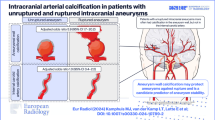Abstract
Objectives
Although lenticulostriate artery (LSA) territorial infarcts usually appear as single subcortical infarctions (SSIs) on imaging, they are caused by various etiological mechanisms. We aimed to investigate the correlation between LSA morphology and the location or size of infarcts. Besides, we explored whether the location or size of infarcts can predict the presence of middle cerebral artery (MCA) plaques and distinguish the different etiological mechanisms of SSI patients.
Methods
We prospectively included patients with acute SSI in the LSA territory. The MCA plaques, infarct features, including the number of infarct slices, lowest infarct layer index (LILI), volume, maximum area and diameter, and LSA morphological characteristics, including the number of stems and branches, length, distance, and tortuosity were evaluated.
Results
A total of 105 patients were enrolled. Both the average length and average distance of LSAs were negatively correlated with the maximum infarct area (P=0.048, P=0.028, respectively) and maximum infarct diameter (P=0.016, P=0.010, respectively) on axial examination and were positively correlated with LILI (P=0.020, P=0.003, respectively). The number of LSA branches was associated with the number of infarct slices (P=0.040) and LILI (P=0.043). Moreover, we found that when the LILI=1 or 2 and the number of infarct slices ≥3, the SSI patients were more likely to have MCA plaques (P=0.045).
Conclusions
SSI patients with a LILI=1 or 2 and infarct slices of ≥3 were more likely to have MCA plaques. Our findings might provide a simple and feasible method to distinguish the different underlying mechanisms of SSIs for clinicians.

Similar content being viewed by others
Data availability
The data that support the findings of our study are available from the corresponding author upon reasonable request.
References
Caplan LR (1989) Intracranial branch atheromatous disease: a neglected, understudied, and underused concept. Neurology 39:1246–1250. https://doi.org/10.1212/wnl.39.9.1246
Wen L, Feng J, Zheng D (2013) Heterogeneity of single small subcortical infarction can be reflected in lesion location. Neurol Sci 34:1109–1116. https://doi.org/10.1007/s10072-012-1187-6
Gao Y, Song B, Yong Q, Zhao L, Ji Y, Dong Y et al (2016) Pathogenic heterogeneity of distal single small subcortical lenticulostriate infarctions based on lesion size. J Stroke Cerebrovasc Dis 25:7–14. https://doi.org/10.1016/j.jstrokecerebrovasdis.2015.08.026
Yamamoto Y, Ohara T, Hamanaka M, Hosomi A, Tamura A, Akiguchi I (2011) Characteristics of intracranial branch atheromatous disease and its association with progressive motor deficits. J Neurol Sci 304:78–82. https://doi.org/10.1016/j.jns.2011.02.006
Nakase T, Yoshioka S, Sasaki M, Suzuki A (2013) Clinical evaluation of lacunar infarction and branch atheromatous disease. J Stroke Cerebrovasc Dis 22:406–412. https://doi.org/10.1016/j.jstrokecerebrovasdis.2011.10.005
Jiang S, Cao T, Yan Y, Yang T, Yuan Y, Deng Q et al (2021) Lenticulostriate artery combined with neuroimaging markers of cerebral small vessel disease differentiate the pathogenesis of recent subcortical infarction. J Cereb Blood Flow Metab 41:2105–2115. https://doi.org/10.1177/0271678X21992622
Tatu L, Moulin T, Bogousslavsky J, Duvernoy H (1998) Arterial territories of the human brain: cerebral hemispheres. Neurology 50:1699–1708. https://doi.org/10.1212/wnl.50.6.1699
Yang Q, Deng Z, Bi X, Song SS, Schlick KH, Gonzalez NR et al (2017) Whole-brain vessel wall MRI: a parameter tune-up solution to improve the scan efficiency of three-dimensional variable flip-angle turbo spin-echo. J Magn Reson Imaging 46:751–757. https://doi.org/10.1002/jmri.25611
Fan Z, Yang Q, Deng Z, Li Y, Bi X, Song S et al (2017) Whole-brain intracranial vessel wall imaging at 3 Tesla using cerebrospinal fluid-attenuated T1-weighted 3D turbo spin echo. Magn Reson Med 77:1142–1150. https://doi.org/10.1002/mrm.26201
Jiang S, Yan Y, Yang T, Zhu Q, Wang C, Bai X et al (2020) Plaque distribution correlates with morphology of lenticulostriate arteries in single subcortical infarctions. Stroke 51:2801–2809. https://doi.org/10.1161/STROKEAHA.120.030215
Wang M, Wu F, Yang Y, Miao H, Fan Z, Ji X et al (2018) Quantitative assessment of symptomatic intracranial atherosclerosis and lenticulostriate arteries in recent stroke patients using whole-brain high-resolution cardiovascular magnetic resonance imaging. J Cardiovasc Magn Reson 20:35. https://doi.org/10.1186/s12968-018-0465-8
Cho HJ, Roh HG, Moon WJ, Kim HY (2010) Perforator territory infarction in the lenticulostriate arterial territory: mechanisms and lesion patterns based on the axial location. Eur Neurol 63:107–115. https://doi.org/10.1159/000276401
Seo SW, Kang CK, Kim SH, Yoon DS, Liao W, Wörz S et al (2012) Measurements of lenticulostriate arteries using 7T MRI: new imaging markers for subcortical vascular dementia. J Neurol Sci 322:200–205. https://doi.org/10.1016/j.jns.2012.05.032
Lammie GA (2002) Hypertensive cerebral small vessel disease and stroke. Brain Pathol 12:358–370. https://doi.org/10.1111/j.1750-3639.2002.tb00450.x
Nah HW, Kang DW, Kwon SU, Kim JS (2010) Diversity of single small subcortical infarctions according to infarct location and parent artery disease: analysis of indicators for small vessel disease and atherosclerosis. Stroke 41:2822–2827. https://doi.org/10.1161/STROKEAHA.110.599464
Shen M, Gao P, Zhang Q, Jing L, Yan H, Li H (2018) Middle cerebral artery atherosclerosis and deep subcortical infarction: a 3T magnetic resonance vessel wall imaging study. J Stroke Cerebrovasc Dis 27:3387–3392. https://doi.org/10.1016/j.jstrokecerebrovasdis.2018.08.013
Yoon Y, Lee DH, Kang DW, Kwon SU, Kim JS (2013) Single subcortical infarction and atherosclerotic plaques in the middle cerebral artery: high-resolution magnetic resonance imaging findings. Stroke 44:2462–2467. https://doi.org/10.1161/STROKEAHA.113.001467
Funding
This work was supported by grants from the National Natural Science Foundation of China (Nos. 82071320 and 81870937) and the 1·3·5 project for disciplines of excellence, Clinical Research Incubation Project, West China Hospital, Sichuan University (No. 2020HXFH012).
Author information
Authors and Affiliations
Corresponding authors
Ethics declarations
Ethical approval and Informed consent statement
This study was approved by the Ethics Committee of West China Hospital, and informed written consent was obtained from all patients.
Conflicting interest
The authors declare no competing interests.
Additional information
Publisher’s note
Springer Nature remains neutral with regard to jurisdictional claims in published maps and institutional affiliations.
Rights and permissions
Springer Nature or its licensor (e.g. a society or other partner) holds exclusive rights to this article under a publishing agreement with the author(s) or other rightsholder(s); author self-archiving of the accepted manuscript version of this article is solely governed by the terms of such publishing agreement and applicable law.
About this article
Cite this article
Yang, T., Tang, L., Jiang, S. et al. A method to distinguish the different etiological mechanisms of single subcortical infarction. Neurol Sci 44, 1703–1708 (2023). https://doi.org/10.1007/s10072-023-06623-0
Received:
Accepted:
Published:
Issue Date:
DOI: https://doi.org/10.1007/s10072-023-06623-0




